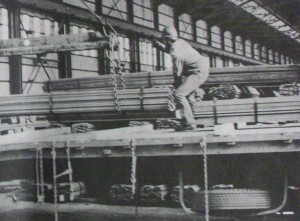Rolling out Flats – A Specialty at Northwestern’s 14 Inch Mill
Retrieved from The Daily Gazette ~ 1979
Transcribed, and minor corrections made, by Dana Fellows ~ 2011
There are over 100,000 uses for the flats that Northwestern Steel and Wire Company produces at the 14 Inch mill. They’re one product that’s used in everything from farm equipment and cars to building construction.
Once the right steel billet or bloom is picked and brought to the correct temperature in a reheat furnace, the work necessary to turn it into a flat begins. The feeder first calls for the billet or bloom from the reheat furnace (whenever the charger adds a billet to reheat furnace, on drops onto the roll line ready to be pulled into the mill stands). The feeder is told by the hot bed operator… the man who controls the cooling bed… exactly when his area can accept another flat.
Once on the roll line, the speed operator, and his helper, is in control working by both, eye and gauge, these two controls the push and pull of the bar by the mill stands which do the actual shaping.
Each mill stand compresses the bar either vertically or horizontally, as the bar’s dimensions are made smaller, its gets longer. The earlier mill stands… called the roughing mills… do more of the work while the stands furthest from the furnace are the finishing stands. These put the final touches on the product such as the exact size, good edges and a nice finish.
The average billet or bloom used in the 14” mill is 32 feet long when it drops from the reheat furnace. By the time it reaches the end of the 375 foot-long line. It can become as long as 400 feet.
Once the bar reaches the proper size and shape, it is rolled onto the cooling bed and comes under the eyes of the hot bed operators, who make sure the flat goes across the bed at a speed that allows it to cool properly, without losing its shape (through bending and warping).
The hot bed hooker then places the flat on the shear roll-line to be cut. The weigher checks customer specifications and tells the shear operator and his helpers what length the customer wants and the sizes of the bundle.
The shear operator cuts the flat and the pieces roll down to the cradle tenders who make up the bundle.
Once cut and bundled, the crane operators place the finished product in piles in the warehouse area by size. It will be shipped according to the customer instructs by the shipping crew, which usually consists of a car checker, hooker loader and the crane operator (who also helps elsewhere in the mill when needed).
During the time the flat is on the roll line, cooling bed, shear line and even just before it is shipped out, the flat is checked and inspected to make sure the customer get the traditional NSW quality product he expects.

